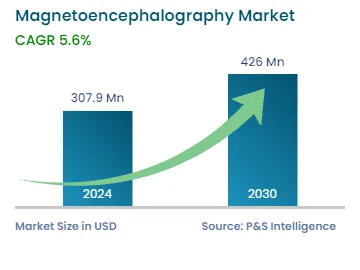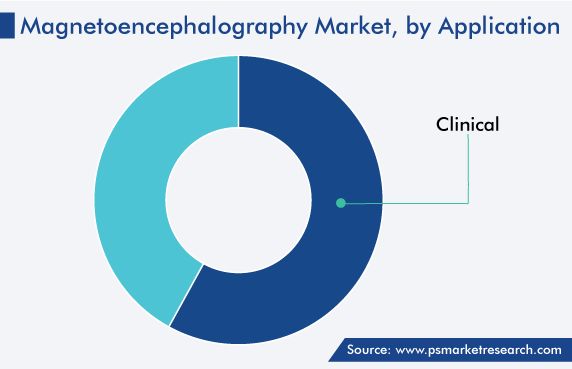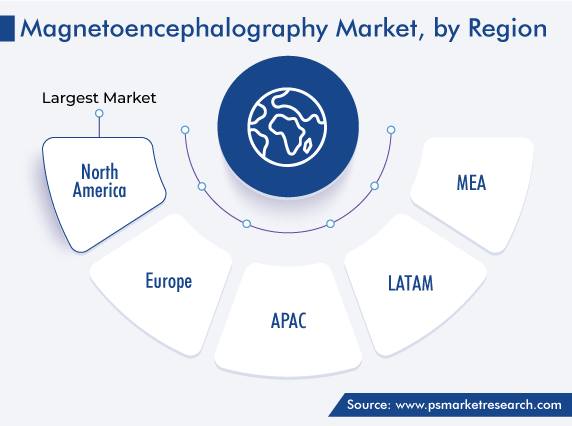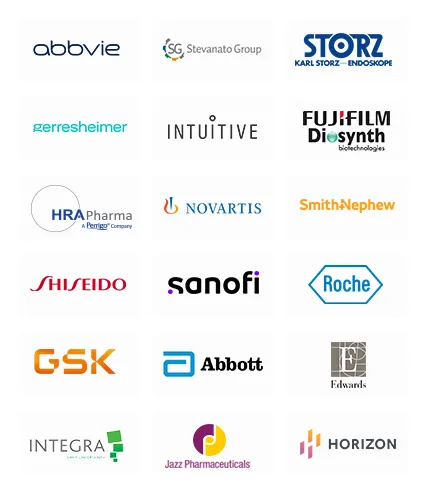Market Statistics
| Study Period | 2019 - 2030 |
| 2024 Market Size | USD 307.9 Million |
| 2030 Forecast | USD 426 Million |
| Growth Rate(CAGR) | 5.6% |
| Largest Region | North America |
| Fastest Growing Region | Asia-Pacific |
| Nature of the Market | Consolidated |
Report Code: 12601
Get a Comprehensive Overview of the Magnetoencephalography Market Report Prepared by P&S Intelligence, Segmented by Type (OPM, SQUIDs), Application (Clinical, Research), End User (Hospitals, Imaging Centers, Academic and Research Institutes), and Geographic Regions. This Report Provides Insights from 2019 to 2030.
| Study Period | 2019 - 2030 |
| 2024 Market Size | USD 307.9 Million |
| 2030 Forecast | USD 426 Million |
| Growth Rate(CAGR) | 5.6% |
| Largest Region | North America |
| Fastest Growing Region | Asia-Pacific |
| Nature of the Market | Consolidated |

Explore the market potential with our data-driven report
The magnetoencephalography market size stood at USD 307.9 million in 2024, and it is expected to advance at a compound annual growth rate of 5.6% during 2024–2030, to reach USD 426 million by 2030. The growth can be primarily ascribed to the rising technological advancements, the surging prevalence of neurological disorders, the increasing focus on the use of non-invasive techniques, and the growing geriatric population.
These scanners show their effectiveness in the detection of epilepsy, brain tumors, dementia, pain perception, sclerosis, and many more neurological problems. Also, without distortion, it is possible that neuromagnetic impulses can pass through the skull and scalp. Moreover, advancements in computer hardware and technologies have increased interest in such devices.
It is evaluated that signals are perceived directly from the neuronal electrical activity and are able to show absolute neuronal activity. This test is more sensitive than others in the detection of interictal spikes, majorly in some parts of the human brain including the lateral temporal neocortex and the superficial frontal cortex. Due to its higher sensitivity, the test is widely used.
The increasing work pressure and stress in life are affecting mental health, which, in turn, is boosting the demand for magnetoencephalography. The increasing job pressure, unhealthy lifestyle, and lack of time are the major reasons leading to stressful lifestyles. According to government articles, the global average percentage of stressed people out of 143 countries is 35%, and in the Americas, it is around 55%.
Stress causes a large number of respondents to feel paralyzed, and due to a stressful lifestyle, people are suffering from various issues including insomnia, frequent changes in mood, heart disease, and obesity. Thus, this drives the market for this test, as it aids in the identification of these types of issues, which makes the treatment easy.
Superconducting quantum interference devices (SQUIDs) hold a larger revenue share, owing to their high spatial resolution, the possibility of examining non-conducting materials, and deeper penetration depths. Moreover, these devices do not require considerable magnetic fields, enable greater scanning distances, and identify weak magnetic fields. Thus, these factors are driving the need for SQUIDs.
Whereas, the demand for optically pumped magnetometers (OPMs) is expected to witness faster growth during the forecast period, owing to their enhanced sensitivity, lower operating cost, and not requiring supercooling. Moreover, these devices also have various other advantages such as higher uniformity of coverage, enhanced spatial resolution, participants can move during scanning, minimized system complexity, and lifespan compliance. Also, it can adapt according to the shape of the head because it is stretchable and the flexibility of its cap ensures the positioning of sensors.
In addition, the cap is lightweight and comfortable to wear, which further fuels the demand for OPMs. Furthermore, the proximity of sensors to the scalp surface is increased so that the devices can detect a magnetic signal with higher amplitude, have improved spatial localization, and do not require reliance on cryogenic sensing in order to make their instrumentation simpler, which, in turn, drives the market growth in this category.
Based on application, the clinical category accounted for a larger revenue share, of around 58%, in 2022. This is ascribed to the rising prevalence of brain problems, such as dementia and epilepsy; and magnetoencephalography provides precise results with an extremely high temporal and spatial resolution, which is required to be superior in clinical settings. Among clinical categories, epilepsy application holds the largest share, due to accurate results and easy identification of locations of seizures of magnetoencephalography. Moreover, it enhances the surgical outcomes of patients suffering from epilepsy and enables the real-time study of the brain.
Furthermore, with the availability of magnetoencephalography, it became feasible to examine the anatomy and functions of the growing brain, which is boosting its demand in research applications. It is also used in understanding the mechanism of neuropsychic disorders and differentiating them from healthy individuals.

The hospitals category holds the largest revenue share, owing to the rising adoption of technologically advanced sensors in hospitals, the presence of a large number of patients, and the increasing number of procedures performed in these healthcare facilities. Additionally, the existence of a large number of hospitals, well-established infrastructure, and the rise in the adoption of non-invasive procedures are boosting the requirement for magnetoencephalography in hospitals.
In addition, the imaging centers category is expected to show significant growth in the coming years. This can be attributed to the lower wait times and low scan costs in imaging centers, the growing reimbursement structure, and the involvement of diagnostic accreditation boards.
Drive strategic growth with comprehensive market analysis
North America has the leading position in the magnetoencephalography market, and it will hold the same position in the coming years, with a value of USD 149 million in 2030. This is attributed to the high adoption of new and advanced technologies and high disposable income in the region. In addition, the next-generation sequencing technology offers quicker and more accurate results, due to which it is used widely in the U.S. and Canada.
According to government websites, there are more than 1,000 neurodegenerative and neurological disorders exist, which are affecting the lives of approximately 100 million Americans. The Americans are spending almost 800 billion every year on their treatment. Thus, the current existence of various problems related to the brain and high spending on such issues are contributing to revenue generation in the regional market.
Moreover, it is predicted that the regional governments have initiated focusing on the reimbursement policy for magnetoencephalography, which leads individuals to adopt such testing methods widely. In addition, because of new technological advancements, doctors and consumers are shifting from invasive methods to non-invasive testing methods.
In North America, the U.S. market holds the leading position, and it will grow with a CAGR of 5.7% during the forecast period. This is attributed to the robust healthcare infrastructure, the existence of a large number of key players, an increase in the number of product launches, high spending on healthcare projects, and high investments in R&D activities in the field of mental health, in the country. For instance, in June 2021, Field Line Inc. launched a novel next-generation device, HEDscan, for non-invasive functional brain imaging. The device is available to researchers who are interested in 3D imaging of brain activity.

Based on Type
Based on Application
Based on End User
Geographical Analysis
The magnetoencephalography market size stood at USD 307.9 million in 2024.
During 2024–2030, the growth rate of the magnetoencephalography market will be around 5.6%.
Hospitals is the largest end user in the magnetoencephalography market.
The major drivers of the magnetoencephalography market include the rising number of imaging centers, the surging advancements in technologies, the increasing cases of neurodegenerative disorders, the growing popularity of non-invasive techniques, the increasing adoption of advanced technology by healthcare facilities, and the growing geriatric population.
Want a report tailored exactly to your business need?
Request CustomizationLeading companies across industries trust us to deliver data-driven insights and innovative solutions for their most critical decisions. From data-driven strategies to actionable insights, we empower the decision-makers who shape industries and define the future. From Fortune 500 companies to innovative startups, we are proud to partner with organisations that drive progress in their industries.


Working with P&S Intelligence and their team was an absolute pleasure – their awareness of timelines and commitment to value greatly contributed to our project's success. Eagerly anticipating future collaborations.
McKinsey & Company
IndiaOur insights into the minutest levels of the markets, including the latest trends and competitive landscape, give you all the answers you need to take your business to new heights
We take a cautious approach to protecting your personal and confidential information. Trust is the strongest bond that connects us and our clients, and trust we build by complying with all international and domestic data protection and privacy laws
Customize the Report to Align with Your Business Objectives
Request the Free Sample Pages